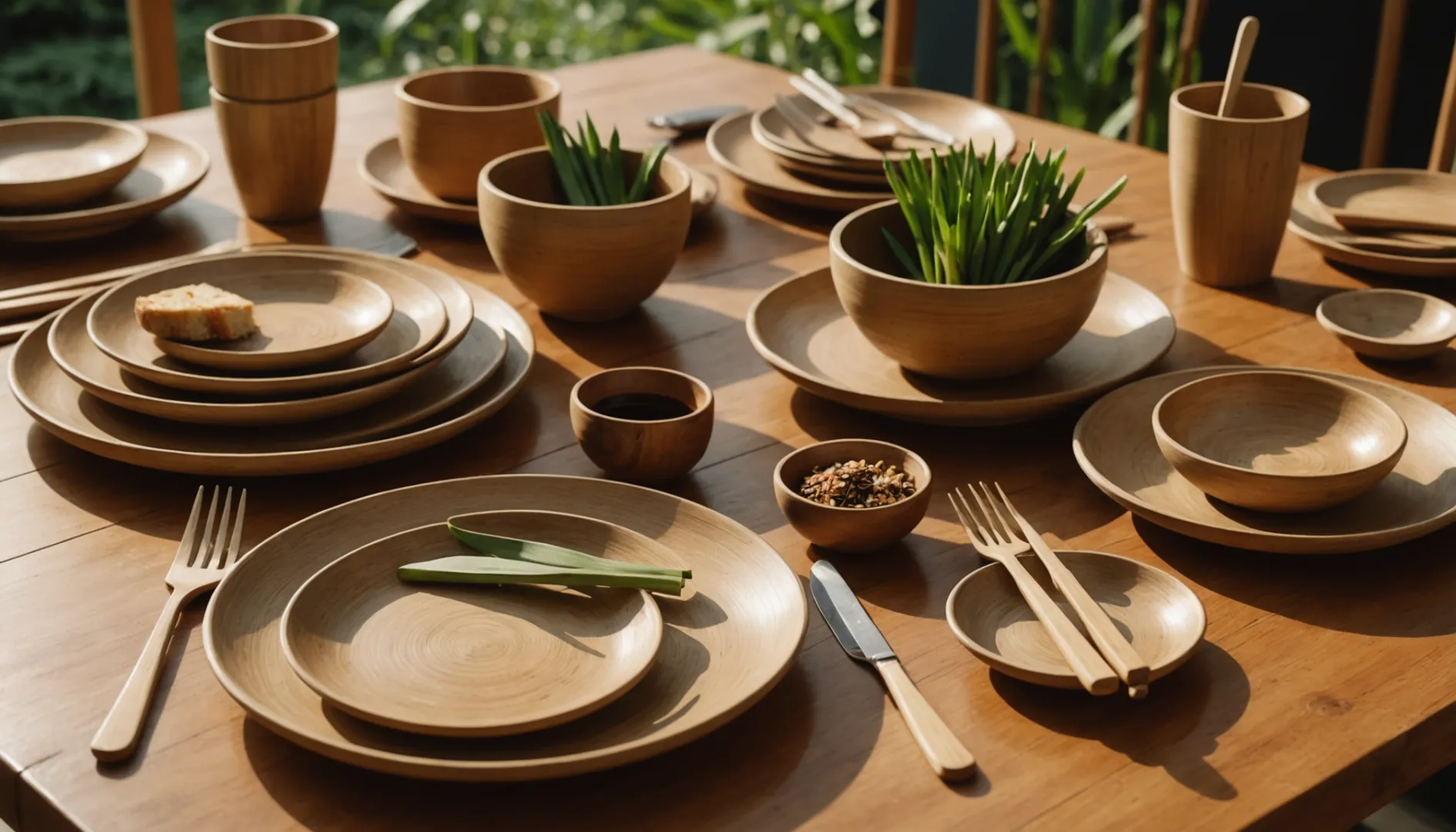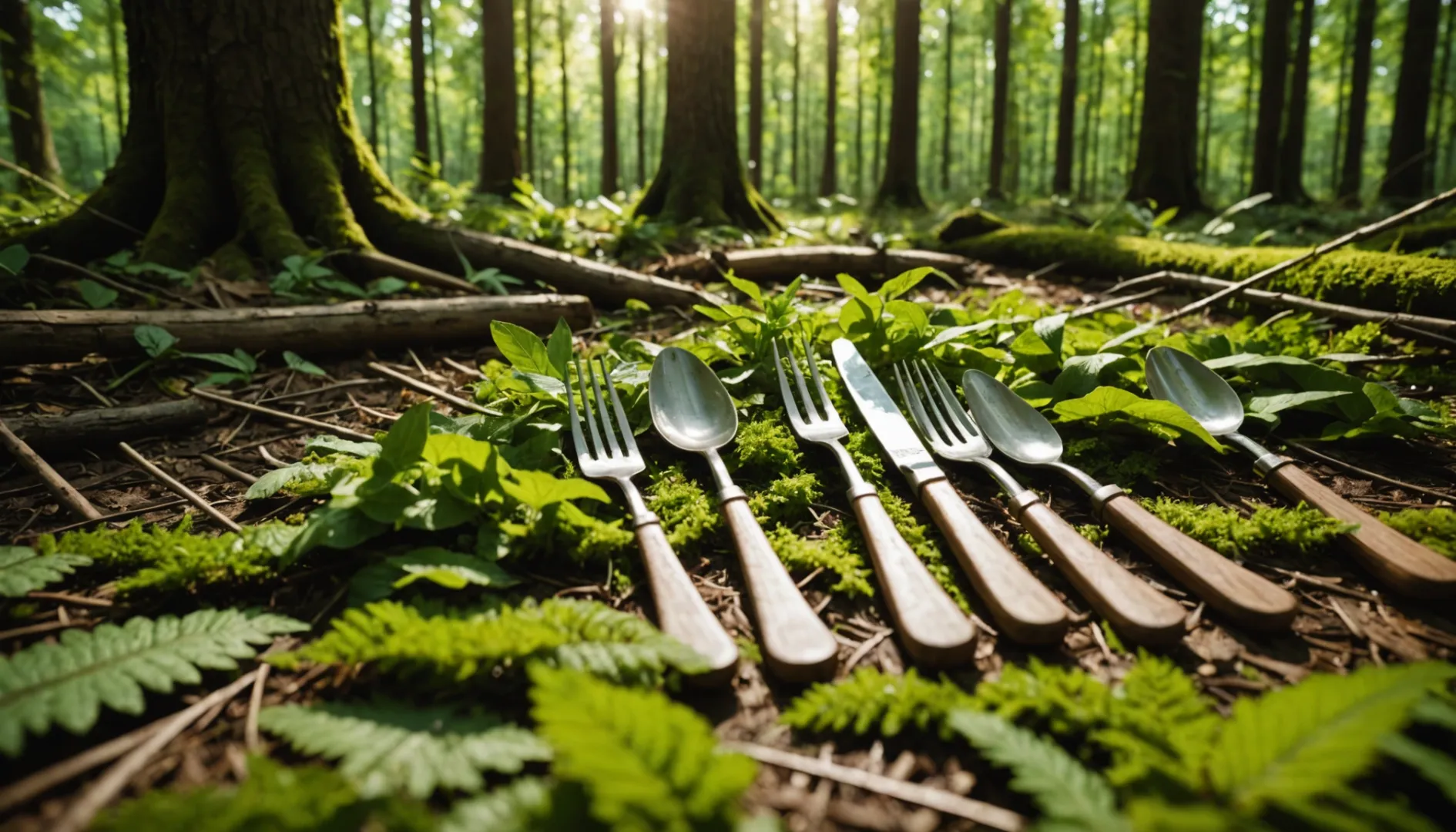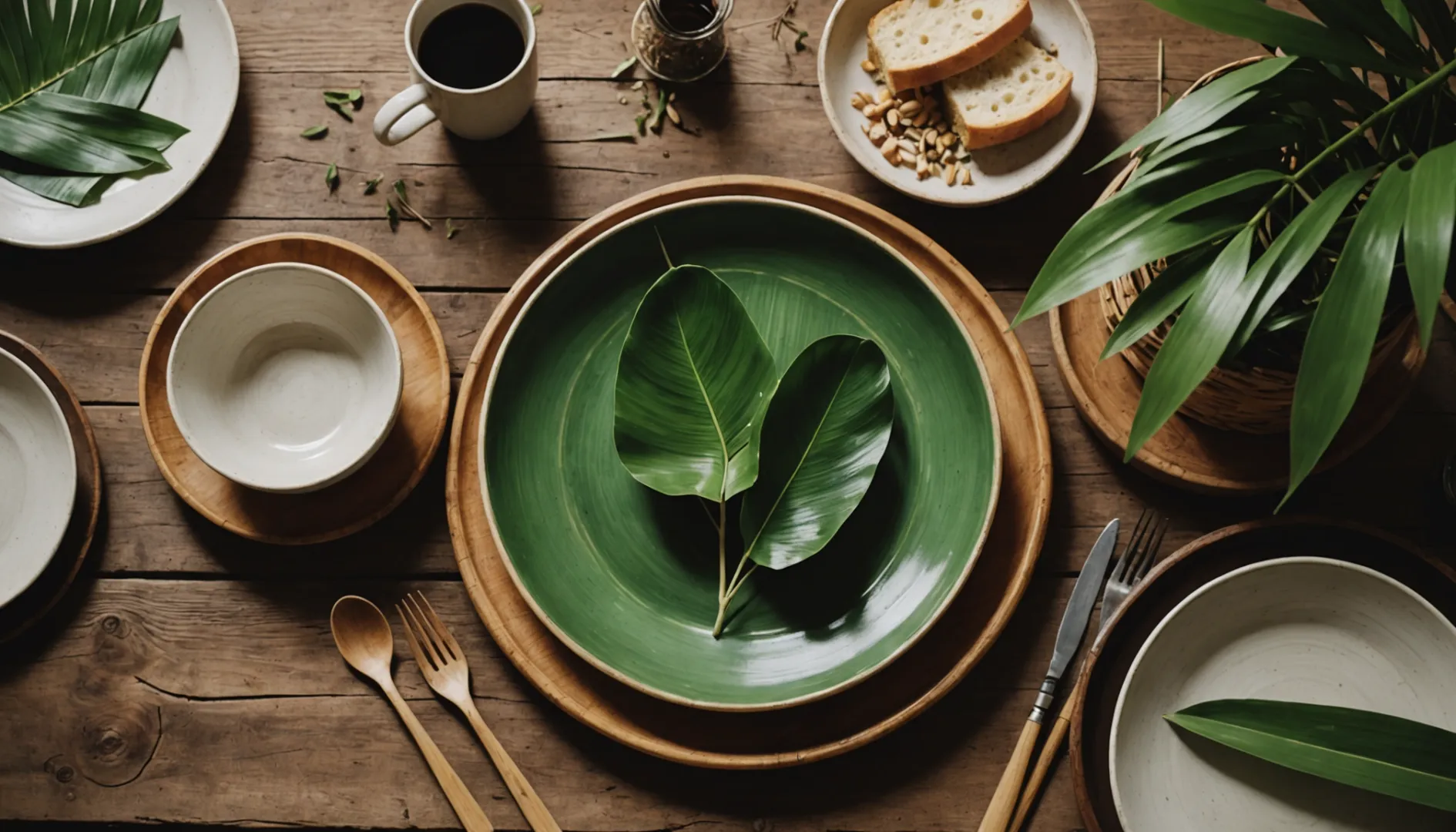
Have you ever thought about why PacknWood's wooden cutlery costs more than others?
PacknWood's wooden cutlery costs more. It uses top-quality, eco-friendly materials. Production methods are sustainable. This brand really cares about strong, compostable products from organic sources. They carefully choose and create these items. Their philosophy mixes ecology with economy.
The initial price might surprise people, but knowing the skill and beliefs behind these products often proves the investment valuable. I once hosted a dinner party and picked PacknWood cutlery. It started interesting talks about sustainability. PacknWood is really special. Their cutlery truly shines in the eco-friendly world.
PacknWood's cutlery is made from recyclable materials.True
PacknWood uses organic and recyclable materials for its products.
Plastic cutlery is more eco-friendly than PacknWood's.False
PacknWood's products are compostable, unlike most plastic cutlery.
How Does PacknWood Ensure Sustainability in Its Products?
I remember the first time I discovered PacknWood's eco-friendly tableware. It was a revelation in a world overrun by plastic. Their commitment to sustainability is truly inspiring. Let's dive into how they make it happen.
PacknWood ensures sustainability by using organic, recyclable materials like wood, bamboo, and PLA. Their "ecolomique" approach balances ecology and economy, making products durable yet compostable, reducing environmental impact.

The Ecolomique Approach
When I first stumbled upon PacknWood's "ecolomique" philosophy, it felt like a breath of fresh air. This innovative blend of ecology and economy is not just a fancy term but a practical approach that ensures their products are environmentally friendly without breaking the bank. Imagine having dinnerware that doesn't just look good but does good for the planet too. By using organic materials1 such as wood, bamboo, and PLA (Polylactic Acid), they create products that are both biodegradable and affordable.
Material Choices and Environmental Impact
I once found myself wondering about the impact of everyday tableware on the environment. With PacknWood, I discovered that the choice of materials can make a world of difference. By prioritizing renewable resources like sugarcane, cornstarch, and palm leaves, they significantly cut down their carbon footprint. Knowing that these materials are sourced from responsible suppliers worldwide reassures me that there's a sustainable supply chain2 supporting our daily meals.
Innovation in Product Design
I’m all about finding practical solutions to everyday problems, and PacknWood's innovations hit the mark. Their microwave-safe mini muffin pans and sugarcane plates showcase a commitment to eco-friendly alternatives that are as functional as they are green. These designs meet consumer needs while minimizing waste since they're fully compostable after use.
Certifications and Compliance
It's one thing to claim sustainability, but proving it is another story. PacknWood backs up their environmental promises with certifications that validate the eco-friendliness of their products. It’s like having a seal of approval that gives me confidence in my choices and ensures transparency in their production processes.
Challenges and Opportunities
Switching to sustainable practices isn't always smooth sailing. I've noticed that the cost of natural materials can be higher, which might deter some buyers initially. But with the growing demand for eco-friendly packaging3, there’s an opportunity for PacknWood to educate consumers about the long-term benefits of going green. This shift not only expands their market share but also fosters a culture of sustainability among us all.
PacknWood uses only organic materials for all products.False
While PacknWood uses many organic materials, not all products are purely organic.
PacknWood's tableware is compostable.True
All of PacknWood's tableware is designed to be compostable.
Why Choose Wooden Cutlery Over Plastic?
Have you ever wondered why more people are switching to wooden cutlery these days?
Wooden cutlery offers numerous benefits over plastic, including environmental sustainability, biodegradability, and safety from harmful chemicals. Unlike plastic, wooden utensils are made from renewable resources and decompose naturally, reducing landfill waste. They also provide a more natural and elegant dining experience.

Environmental Impact
I remember the first time I sat down at a picnic with wooden utensils. It felt good knowing that the fork in my hand wasn't going to end up clogging a landfill for centuries. Wooden cutlery is made from renewable resources like birch or bamboo, and these materials are harvested sustainably. This is a big win compared to plastic, which relies on petroleum and contributes significantly to pollution and waste. The positive environmental impact4 of choosing wooden over plastic utensils cannot be overstated.
Health and Safety
If you've ever been concerned about the chemicals that might leach into your food from plastic utensils, you're not alone. I always worry about BPA or phthalates finding their way into my meal. With wooden cutlery, you can breathe easy knowing these harmful chemicals are nowhere near your dinner plate, making it a safer choice for you and your loved ones by eliminating potential health risks.
Aesthetic and Dining Experience
There's something undeniably charming about setting the table with wooden cutlery. It brings a rustic elegance that plastic just can't compete with. Imagine hosting a dinner party where your guests compliment not just the food but the thoughtful presentation—a touch of elegance and a rustic feel5. That's the kind of dining experience wooden utensils can offer—one that feels both special and environmentally conscious.
Biodegradability and Composting
The idea of leaving behind less waste is important to me, and wooden cutlery makes that possible. It decomposes naturally, unlike plastic that sticks around for hundreds of years. I love knowing that my used utensils can be composted alongside food scraps, returning nutrients back to the earth rather than polluting it. This makes them an excellent choice for those looking to reduce their carbon footprint.
Cost Considerations
Initially, I was hesitant about the cost of wooden cutlery. It seemed pricier than plastic at first glance. But when I considered the long-term benefits—both environmental and health-related—the choice became clear. Plus, buying in bulk can really bring down the cost per unit, making it a smart option for anyone planning large events or seeking sustainable alternatives sustainably6.
PacknWood's products are fully compostable.True
PacknWood uses organic and recyclable materials for compostable products.
First Pack is based in America.False
First Pack, managing PacknWood, is based in France.
Is PacknWood’s Wooden Cutlery Truly Compostable?
Ever wondered if the wooden cutlery from PacknWood is as eco-friendly as it claims? Let’s find out!
Yes, PacknWood's wooden cutlery is compostable. It's made from sustainably sourced materials that break down naturally, minimizing landfill waste. However, achieving complete decomposition requires proper composting conditions.

Understanding Compostability
I remember the first time I switched from plastic utensils to wooden ones. It was during a family picnic, and I felt like I was doing my little bit to save the planet. But the real question was, "Are these wooden utensils really compostable?" So, I did some digging. Compostability is all about breaking down into natural elements without leaving any harmful residue behind. PacknWood's wooden cutlery checks this box because it's made from sustainably sourced wood, which naturally biodegrades.
The Composting Process
Now, here's the tricky part—composting isn't just tossing your wooden fork into the backyard and hoping for the best. It needs a little science and a bit of art, like getting the right mix of nitrogen and carbon, and ensuring there's enough moisture and air circulation. I recall my first attempt at composting in my tiny backyard composter; it took me a while to get it just right! If you’re keen on doing it yourself, understanding composting basics7 will help ensure those wooden forks break down as they should.
Industrial vs. Home Composting
What about home vs. industrial composting? Well, I've learned that while PacknWood’s cutlery can be composted at home, it takes patience—something my busy schedule doesn’t always allow! Industrial facilities, on the other hand, offer a more controlled environment where things break down faster. So whether you're an at-home composter or you prefer dropping off your scraps at an industrial facility, knowing the industrial composting benefits8 might help you decide what works best for your lifestyle.
Environmental Impact and Benefits
Switching to compostable options like PacknWood’s cutlery significantly reduces our carbon footprint—a win for Mother Earth! Every time I choose these over plastic, I feel like I'm contributing to a greener planet. These utensils not only decompose into organic matter but also enrich the soil. Exploring sustainable options9 can help you make informed choices that benefit both you and the environment.
Challenges in Ensuring Compostability
Here's a little hiccup though: ensuring proper disposal is key. If these utensils end up in a regular trash bin with non-compostable waste, their eco-friendly magic won't happen. I learned this the hard way after accidentally tossing some in the wrong bin at a party—oops! Familiarizing yourself with proper disposal methods10 will help maximize their environmental benefits and ensure efficient composting.
PacknWood's wooden cutlery is fully compostable.True
The cutlery is made from organic, recyclable materials, making it compostable.
PacknWood products are only available in Europe.False
Their supply chain spans Asia, Africa, Europe, and North America.
Why Should You Invest in Eco-Friendly Tableware for Your Events?
Ever thought about turning your next event into an eco-friendly celebration that leaves both a positive impression and a minimal environmental footprint?
Investing in eco-friendly tableware for events reduces environmental impact and appeals to guests who value sustainability. Made from renewable materials like bamboo and sugarcane, these products offer durability comparable to traditional options. Choosing sustainable tableware enhances your event's image and supports eco-friendly practices.

Environmental Impact Reduction
I remember hosting a family reunion not too long ago, where I decided to switch things up by using eco-friendly tableware. I was amazed at how much waste we avoided compared to our previous gatherings. Traditional disposable tableware, usually plastic, takes forever to decompose, while our new eco-friendly plates, made from sugarcane11 or bamboo, broke down in just a few months. This small change made me realize how easy it was to reduce our environmental footprint and feel good about our contribution to the planet.
Appeal to Eco-Conscious Guests
At another event, I noticed how guests were genuinely impressed with the eco-friendly options we provided. Many of them were increasingly aware of their own environmental impact and appreciated our commitment to sustainability. Using materials like cornstarch PLA12 sent a clear message that we were serious about protecting the environment. Plus, it boosted our reputation as a socially responsible host.
Versatility and Innovation
I was also pleasantly surprised by the versatility of eco-friendly tableware. Companies like PacknWood offer everything from traditional plates to innovative items like microwave-safe mini muffin pans. This meant I could host anything from a casual backyard BBQ to a fancy dinner party without compromising on style or functionality.
Economic and Social Benefits
Initially, I hesitated because of the higher cost of eco-friendly options. However, I quickly realized that the long-term benefits far outweighed the initial expense. For example, using compostable tableware reduced waste disposal fees and supported local composting efforts. Plus, investing in eco-friendly products aligned my event with values that resonated with modern consumers and businesses13, which felt great.
Quality and Durability
Contrary to what some might think, eco-friendly tableware doesn't mean compromising on quality. Products made from bamboo or sugarcane were just as durable as plastic ones, handling various foods and temperatures with ease. This meant I could maintain high standards at my events while being environmentally conscious. It felt good knowing we were doing our part without sacrificing reliability.
PacknWood uses only organic materials for its products.False
They use both organic and recyclable materials in production.
PacknWood's tableware is as sturdy as plastic alternatives.True
Their products are designed to be durable and sturdy like plastic.
Conclusion
PacknWood's wooden cutlery is pricier due to its commitment to high-quality, sustainable materials and eco-friendly production methods, making it a valuable investment for environmentally conscious consumers.
-
Learn about the benefits of organic materials in packaging. ↩
-
Discover how sustainable supply chains reduce environmental impact. ↩
-
Explore current trends in the demand for eco-friendly packaging. ↩
-
Learn how wooden cutlery helps in reducing pollution. ↩
-
Explore how wooden utensils enhance dining aesthetics. ↩
-
Understand the long-term savings with wooden utensils. ↩
-
Learn how composting works to optimize cutlery decomposition. ↩
-
Discover how industrial composting accelerates decomposition. ↩
-
Find eco-friendly tableware alternatives to reduce environmental impact. ↩
-
Ensure correct disposal for effective composting results. ↩
-
Discover why sugarcane is a top choice for sustainable events. ↩
-
Learn how cornstarch PLA enhances eco-friendly dining experiences. ↩
-
Explore how sustainability boosts brand reputation and customer loyalty. ↩

